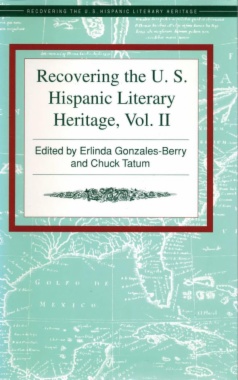"Recovering the U.S. Hispanic Literary Heritage is a compendium of articles by the leading scholars on Hispanic literary history of the United States. The anthology functions to acquaint both expert and neophyte with the work that has been done on this literary history, to outline the agenda for recovering the lost Hispanic literary heritage and to discuss the pressing questions of canonization, social class, gender, and identity that must be addressed in restoring the lost or inaccessible history and literature of any people. As such, this volume of research illustrates Hispanic ethnic and national diversity, the full scope of Hispanic literary expression and the potential for reconstituting what may prove to be a very important chapter in the cultural heritage and overall identity of the United States.
This second volume in the series contains articles divided into in five sections: The Recovery Project Comes of Age
- Cover
- Title page
- Copyright page
- Contents
- Foreword
- Introduction
- Part I. The Recovery Project Comes of Age
- Romancing Hegemony: Constructing Racialized Citizenship in María Amparo Ruiz de Burton’s The Squatter and the Don. John M. González
- Textual and Land Reclamations: The Critical Reception of Early Chicana/o Literature. Manuel M. Martín Rodríguez
- “Who ever heard of a blue-eyed Mexican?”: Satire and Sentimentality in María Amparo Ruiz de Burton’s Who Would Have Thought It?. Anne E. Goldman
- I. “Yankee Popocatapetls”: The American Scene
- II. A “most unnatural liking for foreigners”: The Perverse Piety of Puritan New England
- III. “Who would have supposed such a Vesuvius covered over with New England snows?”: Sexuality and Feminine Agency
- IV. “I come to demand a right”: Lavinia’s Siege of Washington and the Dissolution of Separate Spheres
- V. “blue-eyed Mexican[s]”: Into Mexico
- Notes
- Works Cited
- Part II. Assimilation, Accommodation or Resistance?
- “Fantasy Heritage” Reexamined: Race and Class in the Writings of the Bandini Family Authors and Other Californios, 1828-1965. F. Arturo Rosales
- Origins of the Fantasy Heritage
- Historians and the Fantasy Heritage
- The Bandini Family Writers
- Adjusting “Fantasy Heritage” Application
- The Fantasy Heritage and Mexico
- Roots of the Spanish Heritage Desire in Mexico
- Conclusion
- Notes
- Works Cited
- Outlaws or Religious Mystics? Public Identity and Los Penitentes in Mexican-American Autobiography. Margaret García Davidson
- “We can starve too”: Américo Paredes’ George Washington Gómez and the Proletarian Corrido. Tim Libretti
- Part III. History in Literature/Literature in History
- Having the Last Word: Recording the Cost of Conquest in Los Comanches. Sandra Dahlberg
- Luisa Capetillo: An Anarcho-Feminist Pionera in the Mainland Puerto Rican Narrative/ Political Tradition. Lisa Sánchez González
- Introduction
- Luisa Capetillo
- Conclusion
- Notes
- The Recovery of the First History of Alta California: Antonio María Osio’s La historia de Alta California. Rose Marie Beebe ; Robert M. Senkewicz
- His Authorship
- The Literary Form of the Manuscript
- The Emergence of Osio the Man
- Notes
- Works Cited
- Adina de Zavala’s Alamo: History and Legendry as Critical (Counter-Alamo) Discourse. Richard R. Flores
- The Alamo’s Past
- The Alamo Chronology
- Emplotting Legends
- On Legends and History
- Notes
- Works Cited
- Part IV. Writing the Revolution
- Práxedis G. Guerrero: Revolutionary Writer or Writer as Revolutionary. Ward S. Albro
- Before the Revolution: Catarino Garza as Activist/Historian. Elliott Young
- Catarino Garza: From Journalist to Revolutionary
- The Logic of Events
- Constructing a Complex Racial and National Identity
- The Border Hero: Garza’s Construction of Masculinity
- Constructing Identities
- Works Cited
- Part V. Recovering the Creation of Community
- Spanish-Language Journalism in the Southwest: History and Discursive Practice. Gabriel Meléndez
- A Culture of Print Among Nuevomexicanos
- The Press in the Wake of American Conquest
- The Flowering of Spanish-language Journalism in New Mexico
- Neo-Mexicano Discursive Agency: Camilo Padilla, Pioneer Publisher
- Padilla’s “Historia Original Neo-Mexicana”
- Padilla’s
- Conclusion
- Notes
- Works Consulted
- Cultural Continuity in the Face of Change: Hispanic Printers in Texas. Laura Gutiérrez-Witt
- Introduction
- Printing in Mexico
- Printing in Texas
- Spanish-Language Printing in Texas after 1900
- Four Hispanic Printers in Texas
- Conclusion
- Notes
- Works Cited
- The Tradition of Hispanic Theater and the WPA Federal Theatre Project in Tampa-Ybor City, Florida. Kenya C. Dworkin y Méndez
- Introduction: “We Live in Order Not to Die”
- The Tradition of Hispanic Theater in Tampa-Ybor City
- Federal Theatre Project: “Unemployed actors get just as hungry as anybody else.”
- The demise of the FTP’s Spanish-unit: The ‘Mysterious’ ERA Act of 1937
- Conclusion: The Ghost of the ERA of 1937— ‘It can’t happen here?’
- Notes
- Works Consulted
- Contributors

